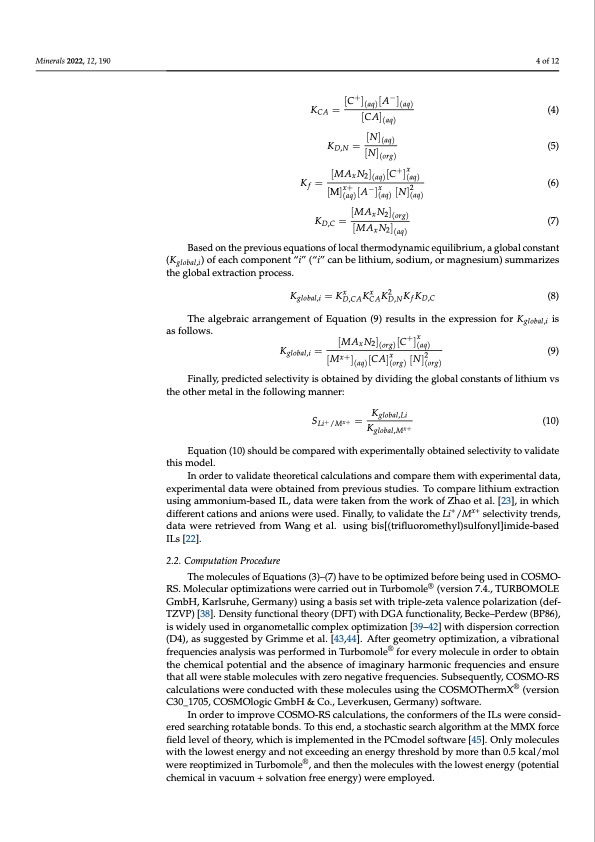
PDF Publication Title:
Text from PDF Page: 004
Minerals 2022, 12, 190 4 of 12 KCA = [C+](aq)[A−](aq) [CA](aq) KD,N = [N](aq) [N](org) (4) (5) (6) (7) [MAxN2] [C+]x (aq) (aq) Kf = KD,C = [MAxN2](org) [M]x+ [A−]x [N]2 (aq) (aq) (aq) [MAxN2](aq) Based on the previous equations of local thermodynamic equilibrium, a global constant (Kglobal,i) of each component “i” (“i” can be lithium, sodium, or magnesium) summarizes the global extraction process. Kglobal,i = KDx ,CAKCx AK2D,NKf KD,C (8) The algebraic arrangement of Equation (9) results in the expression for Kglobal,i is as follows. [MAxN2] [C+]x (org) (aq) (9) [CA]x [N]2 Kglobal,i = Finally, predicted selectivity is obtained by dividing the global constants of lithium vs [Mx+] the other metal in the following manner: SLi+/Mx+ = Kglobal,Li (10) Kglobal,Mx+ Equation (10) should be compared with experimentally obtained selectivity to validate this model. In order to validate theoretical calculations and compare them with experimental data, experimental data were obtained from previous studies. To compare lithium extraction using ammonium-based IL, data were taken from the work of Zhao et al. [23], in which different cations and anions were used. Finally, to validate the Li+/Mx+ selectivity trends, data were retrieved from Wang et al. using bis[(trifluoromethyl)sulfonyl]imide-based ILs [22]. 2.2. Computation Procedure The molecules of Equations (3)–(7) have to be optimized before being used in COSMO- RS. Molecular optimizations were carried out in Turbomole® (version 7.4., TURBOMOLE GmbH, Karlsruhe, Germany) using a basis set with triple-zeta valence polarization (def- TZVP) [38]. Density functional theory (DFT) with DGA functionality, Becke–Perdew (BP86), is widely used in organometallic complex optimization [39–42] with dispersion correction (D4), as suggested by Grimme et al. [43,44]. After geometry optimization, a vibrational frequencies analysis was performed in Turbomole® for every molecule in order to obtain the chemical potential and the absence of imaginary harmonic frequencies and ensure that all were stable molecules with zero negative frequencies. Subsequently, COSMO-RS calculations were conducted with these molecules using the COSMOThermX® (version C30_1705, COSMOlogic GmbH & Co., Leverkusen, Germany) software. In order to improve COSMO-RS calculations, the conformers of the ILs were consid- ered searching rotatable bonds. To this end, a stochastic search algorithm at the MMX force field level of theory, which is implemented in the PCmodel software [45]. Only molecules with the lowest energy and not exceeding an energy threshold by more than 0.5 kcal/mol were reoptimized in Turbomole®, and then the molecules with the lowest energy (potential chemical in vacuum + solvation free energy) were employed. (aq) (org) (org)PDF Image | Ionic Liquids for the Selective Solvent Extraction of Lithium

PDF Search Title:
Ionic Liquids for the Selective Solvent Extraction of LithiumOriginal File Name Searched:
minerals-12-00190-v3.pdfDIY PDF Search: Google It | Yahoo | Bing
Product and Development Focus for Infinity Turbine
ORC Waste Heat Turbine and ORC System Build Plans: All turbine plans are $10,000 each. This allows you to build a system and then consider licensing for production after you have completed and tested a unit.Redox Flow Battery Technology: With the advent of the new USA tax credits for producing and selling batteries ($35/kW) we are focussing on a simple flow battery using shipping containers as the modular electrolyte storage units with tax credits up to $140,000 per system. Our main focus is on the salt battery. This battery can be used for both thermal and electrical storage applications. We call it the Cogeneration Battery or Cogen Battery. One project is converting salt (brine) based water conditioners to simultaneously produce power. In addition, there are many opportunities to extract Lithium from brine (salt lakes, groundwater, and producer water).Salt water or brine are huge sources for lithium. Most of the worlds lithium is acquired from a brine source. It's even in seawater in a low concentration. Brine is also a byproduct of huge powerplants, which can now use that as an electrolyte and a huge flow battery (which allows storage at the source).We welcome any business and equipment inquiries, as well as licensing our turbines for manufacturing.| CONTACT TEL: 608-238-6001 Email: greg@infinityturbine.com | RSS | AMP |